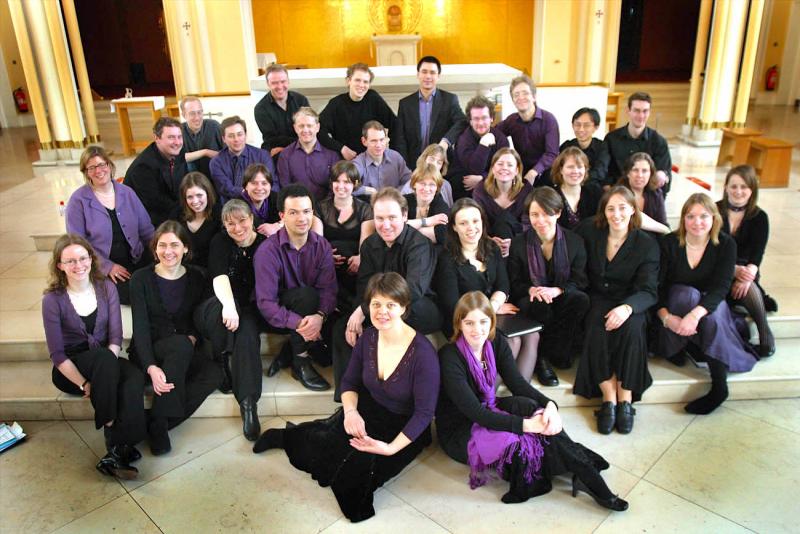Path of Miracles, Elysian Singers, St Pancras Church review – an ambitious musical pilgrimage | reviews, news & interviews
Path of Miracles, Elysian Singers, St Pancras Church review – an ambitious musical pilgrimage
Path of Miracles, Elysian Singers, St Pancras Church review – an ambitious musical pilgrimage
Medieval travellers provide an inspiring challenge to contemporary singers

Path of Miracles is a serious, hefty 65-minute choral work about the traditional Catholic pilgrimage to Santiago de Compostela by – and there is a slight cognitive dissonance here – Joby Talbot, the composer of, among other things, The Hitchhiker’s Guide to the Galaxy film.
Path of Miracles was commissioned in 2005 by the professional choir Tenebrae, who have recorded it twice, as have American choir Conspirare. I have long been a fan of the piece (and Talbot’s work in general) but had never previously heard it live. It is a real challenge for an amateur group, but the Elysian Singers, under Sam Laughton, are as intrepid in their musical exploration as the Santiago pilgrims themselves. I was delighted to see the choir emerging from the last two years, not by playing it safe with old favourites, but by pushing themselves into new territory.
 There are four movements, each of about 15 minutes, tracing the journey from Roncesvalles to its end at Finisterre. The music begins with the men processing onstage as they glissando from the subterranean depths, suddenly crowned with the upper voices from the back of the church singing “Herr Santiagu” on a stratospheric chord. This choreographic element is reversed at the end, as the choir processes off, singing the final phrase on a loop.
There are four movements, each of about 15 minutes, tracing the journey from Roncesvalles to its end at Finisterre. The music begins with the men processing onstage as they glissando from the subterranean depths, suddenly crowned with the upper voices from the back of the church singing “Herr Santiagu” on a stratospheric chord. This choreographic element is reversed at the end, as the choir processes off, singing the final phrase on a loop.
In between, the music conjures up influences of Renaissance church music, European folk music, “holy minimalism” and medieval chant. The text by Robert Dickinson is a masterful tapestry of quotation, allusion and original poetry, in as many as eight languages, and is a real gift to the composer. It offers a solid skeleton for the piece, a framework on which Talbot (pictured above) hangs his musical material. And it is the architecture of the work that is most impressive, sustaining its conceit through such a long span.
It is also the most impressive aspect of the performance: Laughton’s pacing was convincing, and the stamina of the choir through the music’s long paragraphs was remarkable. In the third movement the bright-toned sopranos danced around each other in minimalist loops, like the lights going on after the weary trudge of the second movement. There was a tightness in the insistent rhythmic passages that break up the hymn-like passages, as in the final moments, where the choir found a real warmth of sound. There were only a few moments of vocal uncertainty on some exposed entries but, for an amateur choir with presumably limited rehearsal time, the singing was admirable.
Path of Miracles has a granite certainty to it and was directed with authority by Sam Laughton, for whom this was clearly a personal mission. And the choir went with him. Fully committed to this difficult piece as they were, even if not every note was spot on, they produced an exhilarating evening of choral music that was rightly received very warmly.
rating
Explore topics
Share this article
The future of Arts Journalism
You can stop theartsdesk.com closing!
We urgently need financing to survive. Our fundraising drive has thus far raised £49,000 but we need to reach £100,000 or we will be forced to close. Please contribute here: https://gofund.me/c3f6033d
And if you can forward this information to anyone who might assist, we’d be grateful.

Subscribe to theartsdesk.com
Thank you for continuing to read our work on theartsdesk.com. For unlimited access to every article in its entirety, including our archive of more than 15,000 pieces, we're asking for £5 per month or £40 per year. We feel it's a very good deal, and hope you do too.
To take a subscription now simply click here.
And if you're looking for that extra gift for a friend or family member, why not treat them to a theartsdesk.com gift subscription?
more Classical music
 Solomon, OAE, Butt, QEH review - daft Biblical whitewashing with great choruses
Even a top soprano and mezzo can’t make this Handel paean wholly convincing
Solomon, OAE, Butt, QEH review - daft Biblical whitewashing with great choruses
Even a top soprano and mezzo can’t make this Handel paean wholly convincing
 Two-Piano Gala, Kings Place review - shining constellations
London Piano Festival curators and illustrious friends entertain and enlighten
Two-Piano Gala, Kings Place review - shining constellations
London Piano Festival curators and illustrious friends entertain and enlighten
 Echo Vocal Ensemble, Latto, Union Chapel review - eclectic choral programme garlanded with dance
Beautiful singing at the heart of an imaginative and stylistically varied concert
Echo Vocal Ensemble, Latto, Union Chapel review - eclectic choral programme garlanded with dance
Beautiful singing at the heart of an imaginative and stylistically varied concert
 Scott, Irish Baroque Orchestra, Whelan, RIAM, Dublin review - towards a Mozart masterpiece
Characteristic joy and enlightenment from this team, but a valveless horn brings problems
Scott, Irish Baroque Orchestra, Whelan, RIAM, Dublin review - towards a Mozart masterpiece
Characteristic joy and enlightenment from this team, but a valveless horn brings problems
 Classical CDs: Voice flutes, flugelhorns and froth
Baroque sonatas, English orchestral music and an emotionally-charged vocal recital
Classical CDs: Voice flutes, flugelhorns and froth
Baroque sonatas, English orchestral music and an emotionally-charged vocal recital
 Kanneh-Mason, Britten Sinfonia, Shave, Milton Court - a grin and a big beaming smile
A pair of striking contemporary pieces alongside two old favourites
Kanneh-Mason, Britten Sinfonia, Shave, Milton Court - a grin and a big beaming smile
A pair of striking contemporary pieces alongside two old favourites
 theartsdesk at the New Ross Piano Festival - Finghin Collins’ musical rainbow
From revelatory Bach played with astounding maturity by a 22 year old to four-hand jazz
theartsdesk at the New Ross Piano Festival - Finghin Collins’ musical rainbow
From revelatory Bach played with astounding maturity by a 22 year old to four-hand jazz
 First Person: Manchester Camerata's Head of Artistic Planning Clara Marshall Cawley on questioning the status quo
Five days of free events with all sorts of audiences around Manchester starts tomorrow
First Person: Manchester Camerata's Head of Artistic Planning Clara Marshall Cawley on questioning the status quo
Five days of free events with all sorts of audiences around Manchester starts tomorrow
 Goldscheider, Brother Tree Sound, Kings Place review - music of hope from a young composer
Unusual combination of horn, strings and electronics makes for some intriguing listening
Goldscheider, Brother Tree Sound, Kings Place review - music of hope from a young composer
Unusual combination of horn, strings and electronics makes for some intriguing listening
 theartsdesk Q&A: composer Donghoon Shin on his new concerto for pianist Seong-Jin Cho
Classical music makes its debut at London's K-Music Festival
theartsdesk Q&A: composer Donghoon Shin on his new concerto for pianist Seong-Jin Cho
Classical music makes its debut at London's K-Music Festival

Add comment